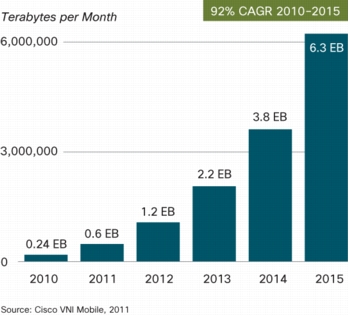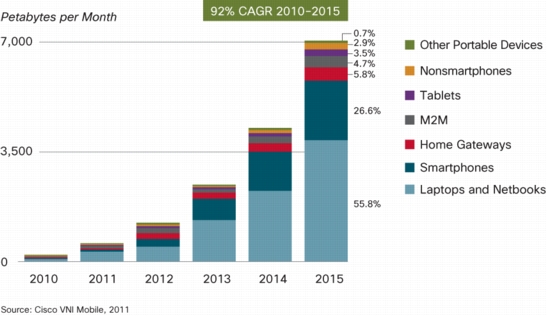
Fig.1: Forecast in Exabytes per Month of Mobile Data Traffic by 2015
What what your first cellphone?
Was it one of those hefty Motorola’s from the 80’s or a 2nd generation flip phone like the “RAZR” or even a PDA/cellphone hybrid? If you were one of the early pioneers of mobile usage then you have been around to see the explosion of cellphone technology over the last two decades moving from simple voice (1G), to voice/text/in-phone features (2G), to voice/text/data/external app access (3G), and soon to you will be headed to a 4G network which is said to increase bandwidth 10 times over and do away with the concept of voice through circuit switching, handling everything over a network connection and single IP address instead.
You have also seen the rise of the “Smart Phone” and other mobile devices that support email clients, calendars, full web browsing, social networking apps, camera’s with easy sharing integration, video players such as youtube, maps, office apps, games, etc. It seems almost counter-intuitive that while these devices get even smaller mobile data traffic rates are skyrocketing but with new technologies and faster networks comes a greater demand for data, mostly in the form of youtube videos. According to Cisco estimates that by 2013 video will be 90 percent of all consumer IP traffic and 64 percent of mobile traffic. That is, unless your company develops an awesome app to grab some of that traffic away from Youtube.
What does mobile applications development mean for Testing Professionals, pro’s and con’s?
Unless you are a QA professional, the combination of mobile applications such as gmail and youtube with the phone you were already carrying around in your pocket has probably been a major upgrade in your life (I know it was when I got one!) but for those of us who test software for a living this poses a whole new set of challenges and opportunity. The combination of a very new environment in which to test (mobile), the yearly tripling of mobile data consumption and the sheer number of applications being developed to serve this increasing demand pose this biggest challenges for any software tester. This can obviously be view as a good thing in terms of job security but nevertheless starts to cause a new headache when you realize there are over 2000 different combination of device, browser, OS, and carriers that an app could potentially need to be tested on.
This sounds like a nightmare. Is mobile application testing really worth it?
Is it really worth the time, money, and effort to push your company’s Website on to mobile devices like the iPad and Android via a custom built application? OF COURSE, the numbers don’t lie. As the overall data consumption explodes so does mobile data comsumption, to the tune of 26% of the total data consumption. So as long as you can build an application that looks and feels like a native version of your website that retains the core functionality your customer’s are looking for, you should definitely go after that piece of the pie.
 Fig.2: Device & Mobile Traffic Growth Comparison 2010-2015
Fig.2: Device & Mobile Traffic Growth Comparison 2010-2015
But do I really need an App for this?
Why can’t my customers use a mobile browser to access my company website? They could, but it won’t function the same because the site was not build to be viewed via a mobile browser and things like loading times and javascript interactions can become slow or convoluted feeling. This is why according to many popular mobile device testing services, “Consumer conversion (from surf to purchase) on iPhone or Android native apps is 3X – 10X times that of mobile web sites. Why? Because users are more comfortable with the device. In most cases, the usability of the native app, including page load speed, is much greater than the mobile web.”
What is 3Qi Labs doing about it?
We realize the huge benefits to supporting our customers mobile testing needs. That’s why 3Qi Labs is currently in the state of integrating support for Selenium 2’s IPhoneDriver and AndroidDriver into our comprehensive test automation framework Awetest. We have been busy for the past several months helping some of our customers re-purpose their current suite of test cases from computer to mobile based browsers/apps. The end goal is to allow Awetest’s users to enjoy all the robust feature functionality Awetest brings to the table to build, test, and manage all their mobile testing needs. Check back with this blog for updates on the completed integration of Selenium 2’s IPhoneDriver and AndroidDriver.

